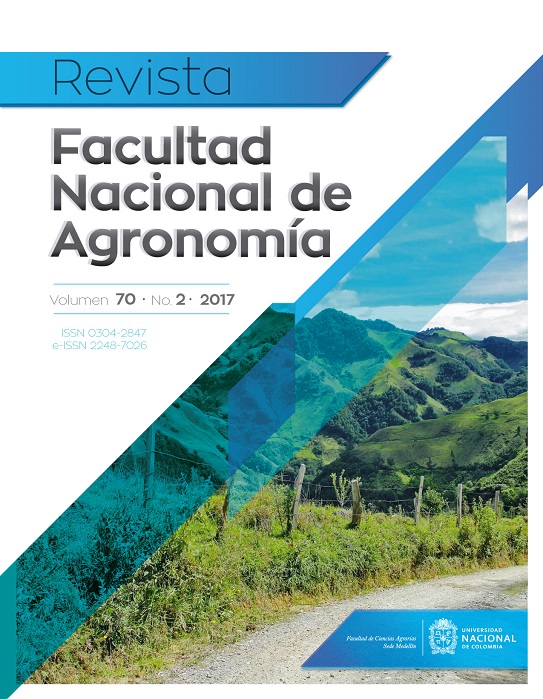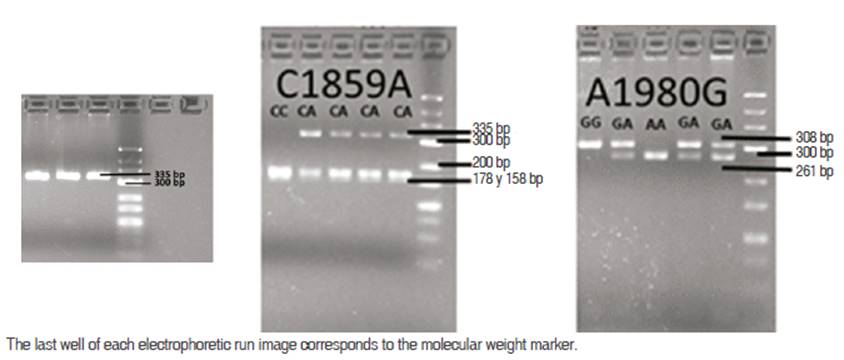Association of TLR6 gene polymorphisms with zootechnical parameters in Holstein cattle in northern Antioquia
Asociación de polimorfismos del gen TLR6 con parámetros zootécnicos en ganado Holstein del norte de Antioquia
DOI:
https://doi.org/10.15446/rfna.v70n2.60766Keywords:
Alelo, Bovinos, Genotipo, Inmunidad, PCR, RFLP (en)alelos, ganado, genotipo, inmunidad, PCR, RFLP (es)
Los sistemas de lechería especializada son uno de los renglones más importantes en el sector agropecuario de Colombia y del mundo. Actualmente existen estrategias, tanto de manejo ambiental como de mejoramiento animal, que buscan optimizar la producción. El gen TLR6, como muchos relacionados con la inmunidad, está demostrando ser un candidato útil para los programas de selección asistida por marcadores moleculares (MAS). Mediante PCR-RFLP, se genotipificaron 432 vacas Holstein de 4 municipios del Norte de Antioquia para los polimorfismos C1859A y A1980G del gen TLR6. Se encontraron frecuencias alélicas de 57,87% para el alelo C y 42,13% para el alelo A de C1859A, y 57,99% para el alelo A y 42,01% para el alelo G de A1980G. Las frecuencias genotípicas de C1859A fueron 84,26% y 15,74% para CA y CC, respectivamente, y no se halló el genotipo AA para este polimorfismo; las frecuencias fenotípicas de A1980G fueron 25,93%, 64,12% y 9,95% para AA, GA y GG, respectivamente. Se utilizaron modelos mixtos de repeticiones con efecto aleatorio del animal para determinar asociación entre los genotipos y las características zootécnicas producción de leche, porcentajes de proteína y grasa, servicios por concepción, IEP y SCS. Ambos polimorfismos solo tuvieron efecto significativo (P<0,01) sobre la característica SCS, siendo el alelo C de C1859A y el alelo A de A 1980G los más favorables. El gen TLR6, mostró un efecto sobre el parámetro SCS de calidad de leche, como se espera por su role inmunológico en la respuesta contra bacterias, y puede ser postulado como marcador molecular para la selección en contra de enfermedades infecciosas de importancia en producción animal, como la mastitis.
Recibido: 19 de septiembre de 2016; Aceptado: 16 de febrero de 2017
ABSTRACT
Specialized dairy systems are one of the most important lines in the agricultural sector in Colombia and the world. Currently there are strategies, both of environmental management and animal breeding, seeking to optimize the production. TLR6 gene, as many others related to immunity, is proving to be a useful candidate for programs of Marker Assisted Selection (MAS). Four hundred thirty two Holstein cows from 4 municipalities of northern Antioquia were genotyped using PCR-RFLP for C1859A and A1980G polymorphism of TLR6 gene. Allelic frequencies of 57.87% were found for C allele and 42.13% for A allele of C1859A, and 57.99% for A allele and 42.01% for G allele of A1980G. Genotypic frequencies of C1859A were 84.26% and 15.74% for CA and CC, respectively, and no AA genotype for this polymorphism was found; phenotypic frequencies of A1980G were 25.93%, 64.12% and 9.95% for AA, GA and GG, respectively. Mixed models for repeated measures with random effect of the animal were used to determine the association between genotypes and milk yield, percentages of protein and fat, services per conception, calving interval, and SCS. Both polymorphisms were only significant (P<0.01) on the SCS feature, being C allele of C1859A and A allele of A1980G the most favorable. TLR6 gene showed an effect on quality milk trait SCS, as expected for its immunological role in the response against bacteria, and can be postulated as molecular marker for selection against infectious diseases of importance in animal production, such as mastitis.
Keywords:
Allele, Cattle, Genotype, Immunity, PCR, RFLP.RESUMEN
Los sistemas de lechería especializada son uno de los renglones más importantes en el sector agropecuario de Colombia y del mundo. Actualmente existen estrategias, tanto de manejo ambiental como de mejoramiento animal, que buscan optimizar la producción. El gen TLR6, como muchos relacionados con la inmunidad, está demostrando ser un candidato útil para los programas de selección asistida por marcadores moleculares (MAS). Mediante PCR-RFLP, se genotipificaron 432 vacas Holstein de 4 municipios del Norte de Antioquia para los polimorfismos C1859A y A1980G del gen TLR6. Se encontraron frecuencias alélicas de 57,87% para el alelo C y 42,13% para el alelo A de C1859A, y 57,99% para el alelo A y 42,01% para el alelo G de A1980G. Las frecuencias genotípicas de C1859A fueron 84,26% y 15,74% para CA y CC, respectivamente, y no se halló el genotipo AA para este polimorfismo; las frecuencias fenotípicas de A1980G fueron 25,93%, 64,12% y 9,95% para AA, GA y GG, respectivamente. Se utilizaron modelos mixtos de repeticiones con efecto aleatorio del animal para determinar asociación entre los genotipos y las características zootécnicas producción de leche, porcentajes de proteína y grasa, servicios por concepción, IEP y SCS. Ambos polimorfismos solo tuvieron efecto significativo (P<0,01) sobre la característica SCS, siendo el alelo C de C1859A y el alelo A de A1980G los más favorables. El gen TLR6, mostró un efecto sobre el parámetro SCS de calidad de leche, como se espera por su role inmunológico en la respuesta contra bacterias, y puede ser postulado como marcador molecular para la selección en contra de enfermedades infecciosas de importancia en producción animal, como la mastitis.
Palabras clave:
Alelo, Bovinos, Genotipo, Inmunidad, PCR, RFLP.The dairy sector is one of the leading in agricultural production in the world, being milk the main livestock product in most countries where it is produced (Hemme et al., 2012; Knips, 2005). In Colombia, this sector covers 6.4% of dairy herds, producing up to 6716 million liters in 2014 (FEDEGAN, 2014, 2015). In specialized dairy, predominantly in the department of Antioquia, the most common breed is Holstein, which extensive information has been collected in recent years due to record management (Jaramillo and Areiza, 2012).
To optimize production and reproduction, especially in specialized dairy, modern techniques and technologies have been adopted, particularly regarding the selection of the animals and their traits. One of these techniques is Marker-Assisted Selection (MAS), which uses gene variations that confer advantage as a selection criterion (Singh et al., 2014). One of the candidate genes to be used as a molecular marker is TLR6, which is a receptor of antigen-presenting cells that can form complexes with TLR2 (Takeda and Akira, 2005), and together may recognize different bacterial antigens, especially zymosan, lipopeptides and lipopolysaccharide (Kang et al., 2011). TLR receptors, including TLR6, have been linked with reproduction and immunological traits (Kannaki et al., 2011) as resistance to bacterial diseases like tuberculosis (Sun et al., 2012; Song et al., 2014) or mastitis (Wang et al., 2007; Russell et al., 2011) and quality milk traits like SCS (Sharma et al., 2006; Chu et al., 2009; Zhang et al., 2009; Beecher et al., 2010).
Every day, the demand for dairy products in our country grows and zootechnical ways for supply it are needed. Due to TLR's role in immune response and health of the animal, and due to only Ramírez et al. (2014) have studied TLR receptors and their effect on cattle traits in Colombia, it is important to know, first, the circulating TLR6 polymorphisms genotypes in our cattle populations, and second, if there is a significant effect of the gene on zootechnical traits; all of this for a better designing of breeding and genetic improvement programs in dairy herds.
The aim of this study was to associate C1859A and A1980G polymorphisms of TLR6 gene to productive and reproductive parameters of Holstein cattle in northern Antioquia, to determine favorable alleles for these parameters.
MATERIALS AND METHODS
Place and experimental units
Blood samples from 432 Holstein cows of municipalities of the northern subregion of Antioquia (Colombia) Belmira, San Pedro de los Milagros, and Entrerríos, and from the small town of San Felix, municipality of Bello, were taken. These cows belong to the project "Genetic Evaluation and Dairy Control Program" from the BIOGEM group of the Universidad Nacional de Colombia, Medellín Campus, and Colanta LTDA.
Blood samples were taken by puncture in the middle coccygeal vein and were collected in BD Vacutainer tubes with purple system (EDTA as anticoagulant). They were kept under refrigeration until processing (extraction of DNA), in the Laboratory of Basic Animal Science at the Universidad Nacional de Colombia, Medellín Campus.
DNA extraction and genotyping by PCR-RFLP
DNA extraction was carried out by salting out procedure (Miller et al., 1988). For amplification by PCR and genotyping by RFLP for C1859A and A1980G polymorphisms, primers and protocols described by Song et al. (2014), which amplify from position 1689 to 2023 of exon 3 of TLR6 gene, according to the sequence NM_001001159 reported in GenBank, were used. Primers used were F: 5'-GGTATCTTTAGCAGCCTTTCCATAC-3' and R: 5'-GTCACAGCAACAGCCAGCA-3' and PCR protocol was done in a total volume of 25 µL containing 0,4 mM of each dNTP, 1 µM of each primer, 2.5 µL of 10X buffer, 2.5 µL of 25 mM MgCl2, ultrapure water, 1 unit of Taq DNA polymerase and from 100 to 200 ng of genomic bovine DNA. Amplification was done with the following program of thermocycling: initial denaturation at 94 °C for 5 min, followed by 35 cycles of denaturation at 94 °C for 40 s, alignment at 65 °C for 30 s, extension at 72 °C for 30 s, followed by a final extension at 72 °C for 7 min. The expected bands are 335 bp.
Digestion with BstXI enzymes (for C1859A polymorphism) and BclI (for A1980G polymorphism) was performed in a final volume of 10 µL, including 3 µL of the PCR product, 5 units of restriction enzyme, 1 µL of the corresponding buffer and ultrapure water. Reactions were incubated at 37 °C for 16 hours and visualized on 3% agarose gels stained with EZ-Vision. The bands obtained by digestion with BstXI were of 335 bp for AA genotype, 335 bp/178 bp/158 bp for CA genotype and 178 bp/157 bp for CC genotype. The bands obtained by digestion with BclI are 308 bp/27 bp for GG genotype, 308 bp/261 bp/47 bp/27 bp for GA genotype and 261 bp/47 bp/27 bp for AA genotype. Bands of 47 and 27 bp are not displayed on the gel due to its size and staining resolution (Figure 1).
Figure 1: PCR and RFLP banding patterns.
Frequencies calculation and Hardy - Weinberg equilibrium
Frequencies were calculated as the proportion between alleles, genotypes or haplotypes of each type and the total of alleles, genotypes or haplotypes in the population, as Hartl described it in 2007. Hardy - Weinberg equilibrium state was calculated with allelic frequencies observed and expected in software GenAlEx 6.503 (Peakall and Smouse, 2012).
Evaluated productive and reproductive parameters
All information of the animals and of all animal lactations were compiled by the "Genetic Evaluation Program and Dairy Control" for 5 years. The parameters evaluated were total milk yield (TMY) in Kg, percentages of protein and fat in milk per lactation (PP and FP), amounts of protein and fat in milk per lactation (PA and FA) in Kg, calculated with each percentage and the total milk yield, calving interval (CI), services per conception (SxC), and somatic cell score (SCS), calculated by logarithmic transformation of somatic cell count in milk (SCC) with the formula:

Data were adjusted by eliminating extreme values that could alter the performance of the model; lactations under 250 days and over 450 days, TMY under 2500 kg and over 12000 kg and SxC equal to 0 were removed.
Association of polymorphisms with productive and reproductive parameters
Descriptive analysis of the evaluated parameters was made and frequency tables were used to characterize averages of the parameters according to genotype. To make the association, a mixed model with random effect of the animal and Tukey's range test was used. The models for each trait were evaluated by the Bayesian Information Criterion (BIC), which value indicates the quality of the model; while the value is lower, the model fits better. A linear regression was used to assess the effect of the substitution of each allele, and averages were evaluated. All calculations were made with SAS® software version 9.2 for Windows (SAS Institute Inc, Cary NC, USA).
The mixed model was:

Being:
Y ijklmnop: Productive or reproductive trait μ: Population average of productive or reproductive trait N i: Effect of number of calvings
Contemporary group:
H j: Effect of herd A k: Effect of calving year Ml : Effect of calving month G m: Fixed effect of the gene (genotype) L n: Effect of lactation duration P o: Effect of the total milk yield per lactation E ijklmnop: Random experimental error
For TMY trait, P o variable was not used
The linear regression model was:

Being:
Yijk: Productive or reproductive trait β0 : Intersection or constant βi , βj , βk: Parameters of each variable L i: Effect of lactation duration G j: Fixed effect of the alleles P k: Effect of the total milk yield per lactation
RESULTS AND DISCUSSION
C1859A and A1980G polymorphisms of TLR6 gene of 432 animals from the municipalities of Bello, Belmira, Entrerríos and San Pedro de los Milagros were amplified. The first polymorphism generates no amino acid change and the second causes a change from isoleucine to valine, which, although is also an apolar and hydrophobic amino acid, has lower molecular weight. The three genotypes of A1980G polymorphism were found, but for C1859A polymorphism only CA and CC genotypes were found in the analyzed population (Table 1). The most frequent alleles were C for C1859A polymorphism and A for A1980G polymorphism; the most frequent genotypes were heterozygous ones in both polymorphisms and, in the case of A1980G, GA is followed by AA genotype. C1859A/A1980G most common haplotype was the CA/GA, followed by CC/AA, CA/AA and CA/GG. By municipality CA/GA remains the most common haplotype, followed by CC/AA, except in Bello, where it is followed by CA/GG; in Belmira, CA/AA and CA/GG haplotypes are equally represented, as are CC/AA and CA/AA haplotypes in Entrerríos. AA genotype of A1980G polymorphism was the only one found with the two genotypes of C1859A polymorphism; the other two were always found with genotype CA of C1859A.
Table 1: Allele, genotype and haplotype frequencies by municipality.
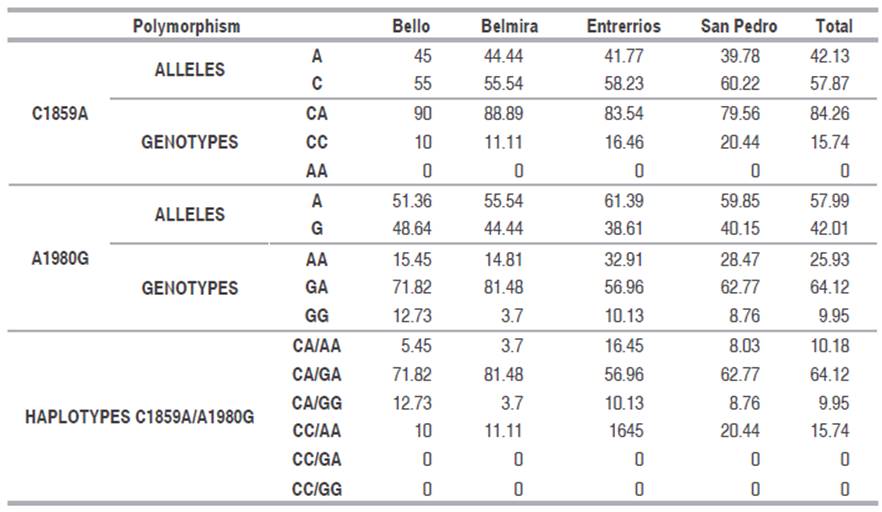
Genotypic and allelic frequencies found are similar to the only two papers reported for these polymorphisms. Song et al. (2014) reported frequencies in Holstein cattle in China above 70% for CA genotype of C1859A polymorphism, followed by CC and AA, which was below 10%, which shows its low frequency in other populations of Holstein cattle and allows to suggest that this allele may be disappearing due to the selection processes that Holstein breed has been subjected to. For A1980G polymorphism, the most common genotype was GA, having a frequency of almost 60%. Chu et al. (2009) did not find AA genotype either and found allelic and genotypic frequencies in Holstein cattle from China very similar to those found in this work; reporting allele frequencies of 58.9% for C and 41.1% for A; and genotype frequencies of 17.8% for CC and 82.2% for CA. For A1980G polymorphism, allele frequencies of 54.3% for A and 45.7% for G; and genotype frequencies of 26% for AA genotype, 56.7% for GA and 17.3% for GG were found (Chu et al., 2009).
In Table 2 are shown the X2 and P values of Hardy - Weinberg equilibrium state analysis. All polymorphisms in all municipalities are in disequilibrium state, except A1980G polymorphism in Belmira. As said above, the artificial selection processes the Holstein cattle suffer may be causing the frequencies of some alleles of TLR6 polymorphisms are reducing.
Table 2: Hardy - Weinberg Equilibrium analysis.
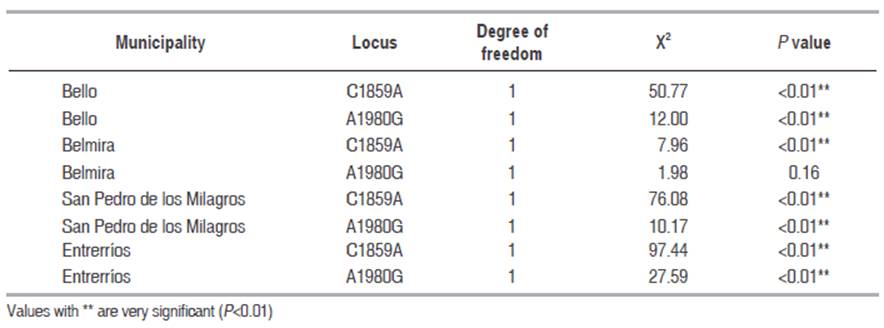
In Table 3, the mean and CV of the analyzed traits are shown.
Table 3: Mean of the evaluated trait.
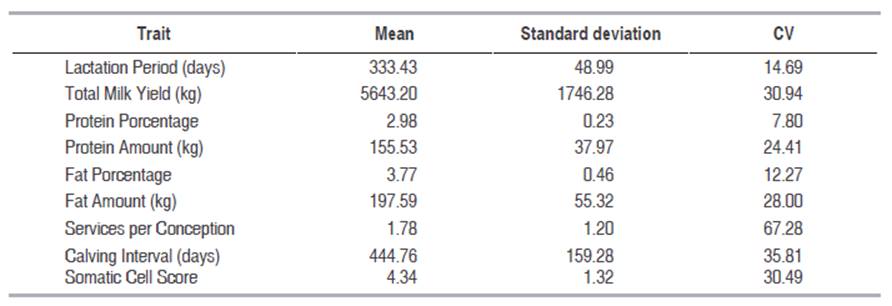
The average milk yield found in this work (5643.2 kg) is higher than that recorded by Quijano et al. (2011), 5140 kg per lactation; protein (2.9%) and fat percentage (3.77%) of this study are similar to those reported by this author (3.07% and 3.8% respectively), but the CI (445 days) was greater than the one they found (417 days). The Holstein Association of Colombia recorded a higher average yield of (6237 kg) and SxC (2.57). Jaramillo et al. (2012), reported for the so called Region 1, which covers departments known for its dairy orientation including Antioquia, protein and fat percentages of 3.07 and 3.63 respectively for 2012; nationwide, they reported 3.1% and 3.66% respectively. The SCS found in this study was considerably higher than the 3.06 reported by Quijano et al. (2011), probably due to the smaller sample number and the smaller number of analyzed regions in this work. Gaviria et al. (2014) also reported SxC of 1.66 in different municipalities of Antioquia, being more favorable the results of this study. Also they recorded in different municipalities of the northern region of Antioquia an adjusted milk yield to 305 days of 5588 kg, protein and fat percentages of 3.06 and 3.89 respectively, a SCS of 4.19, a CI of 414 days and a SxC of 1.67; these results show a better trend than those found in this work, with higher yields and lower CI and SCS (Gaviria et al., 2014, 2015 ).
The association analysis showed that none of the polymorphisms had a significant effect on the evaluated trait, except for SCS, in which the effects were significant (P<0.01), including the effect of the haplotype (Tables 4 and 5). Since from C1859A polymorphism only CA and CC genotypes were found, were these genotypes the ones that had significant differences (P=0.0042); in the case of A1980G polymorphism, which both homozygous genotypes were found, there was a significant difference between GA and AA genotypes (P=0.0143). The difference of SCS between C1859A/A1980G haplotypes, with P=0.0087, was among CA/GA and CC/AA (Table 6). Both statistical association and the comparison of averages between genotypes and haplotypes indicate a favorable effect of C allele of C1859A and A allele of A1980G on the SCS feature.
Table 4: Trait means of C1859A genotype.

Table 5: Trait means of A1980G genotype.
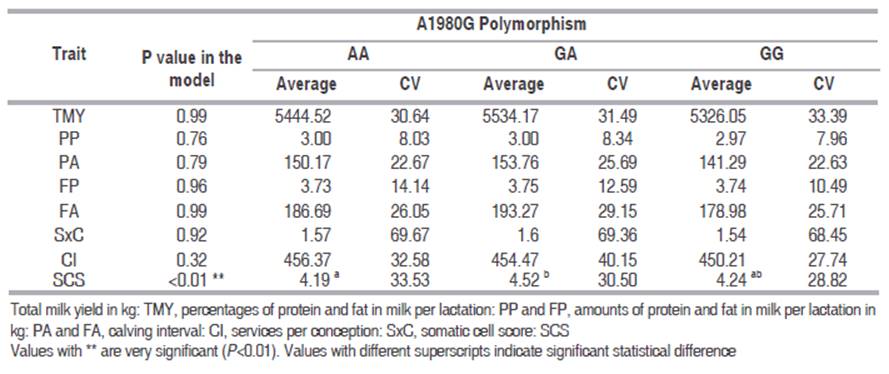
Table 6: Trait means of C1859A/A1980G haplotype

In the work of Chu et al. (2009) it was found that A allele of A1980G polymorphism confers resistance to mastitis, giving SCS values significantly lower than the G allele, but found no association between C1859A polymorphism and mastitis. Chu et al. (2009) also associated other polymorphisms of TLR6, T853A and G855A, with mastitis, being T and G alleles, respectively, which confer resistance. In addition, Song et al. (2014) related both polymorphisms with resistance to tuberculosis, being alleles C of C1859A and G of A1980G favorable, demonstrating that these polymorphisms may be useful selection molecular markers against bacterial diseases.
In both polymorphisms, homozygous genotypes were more favorable than heterozygous genotypes, that is, they had lower SCS values. Although genetic variability (heterozygosity) is usually desirable in immune response related genes (Penn et al., 2002) and usually heterozygous genotypes of these genes confer some advantage, for the so - called "hybrid vigour" or "heterosis", for these polymorphisms, homozygous genotypes are the ones that confer advantage in the SCS trait. Since SCS is usually related to clinical and subclinical mastitis and can serve as an indirect indicator of this type of disorders, a possible explanatory hypothesis offered in this work to the apparent advantage conferred by homozygosity in the studied population is based on the antibacterial function of TLR6.
It is known that several bacterial pathogens are related to mastitis, but the main reported in Colombia are Staphylococcus aureus, Streptococcus agalactiae, and Streptococcus dysgalactiae, and its prevalence is always the highest but it can be sectioned and depends on the region (Calderón and Rodriguez, 2008; Ramírez et al., 2011; Rangel et al., 2011; Trujillo et al., 2011). Since this 3 species of bacteria are the main cause of mastitis in Colombia, and bacteria of this same genus are highly related, it may be the case that a single allele of immunity is favorable or effective against all of them and genetic variability seems not so necessary. Similarly, as homozygous individuals for this favorable allele can produce more protein product of the same type, and if this product is the most effective then are these individuals who have the advantage over the heterozygous individuals.
A contrasting example of what was found in this work is what Chu et al. reported in 2009, who found that the more favorable allele of A1980G was G, suggesting that the effect of this allele is more effective against pathogenic microbiota own of Chinese Holstein cattle, which is probably different from the pathogenic microbiota in Colombia; on the other hand, they found significant differences among all genotypes, being GG the better, followed by GA and this followed by AA, which does not match with the findings of the present study. More studies are needed then, where the number of herds, number of animals and data per animal are higher and allow more reliability and more concrete results that match or refute these studies.
Table 7: Changes in traits with each allelic substitution.

The analysis of allelic substitution to establish the trait changes with each change of allele only yielded significant effect on the SCS (Table 7). For C1859A polymorphism changing each C for A is unfavorable for TMY, SXC, CI and SCS, while changing each A for G in A1980G polymorphism is unfavorable for PP, PA and SCS. The change from CC to AA in the C1859A polymorphism can generate an increase up to 0.74 and the change from AA to GG in A1980G polymorphism can generate an increase up to 0.22 in SCS.
CONCLUSIONS
Allelic and genotypic frequencies of C1859A and A1980G polymorphisms of TLR6 gene for 432 Holstein cows from northern municipalities of Antioquia were determined. The most common alleles were C for the first polymorphism and A for the second, being heterozygous ones the most common genotypes; although analyzing allelic frequencies, not allele fixation is shown, it is possible that A allele of C1859A may be suffering a process of negative selection in improved Holstein cattle, since no AA genotype was found in the population, which is concordant with reports made by other authors. The only significant effect of polymorphisms was found on the SCS trait, expected result because this gene is involved in the immune response against bacterial pathogens; C allele of C1859A and A allele of A1980G were the most favorable alleles. The results were not completely conclusive because the heterozygous genotypes were the worst performers, contrary to expectations, especially in immune-related genes. Probably homozygosity is favorable due to the relatively narrow spectrum of main mastitis pathogens. More studies that better characterize the genotype of the population of Holstein cattle in dairy municipalities of Antioquia are needed and for they continue to design better selection strategies, especially when the goal is to improve SCS without altering or changing other traits.
REFERENCES
References
Beecher C, Daly M, Childs S, Berry DP, Magee DA, McCarthy TV, Giblin L. 2010. Polymorphisms in bovine immune genes and their associations with somatic cell count and milk production in dairy cattle. BMC Genetics 11: 99. doi: 10.1186/1471-2156-11-99
Calderón A, Rodríguez VC. 2008. Prevalence of bovine mastitis and its infectious etiology in specialized milk production systems at cundiboyacense plane (Colombia). Revista Colombiana de Ciencias Pecuarias 21(4): 582-589.
Chu MX, Miao LC, Hai SW. 2009. Polymorphism of TLR6 gene and its relationship with somatic cell score in Holstein cows (China). Acta Veterinaria Et Zootechnica Sinica 40(11): 1621-1629.
FEDEGÁN. 2014. Análisis del inventario ganadero colombiano: comportamiento y variables explicativas. En: FEDEGÁN, En: FEDEGÁN, http://www.fedegan.org.co/publicacion-presentaciones/analisis-del-inventario-ganadero-colombiano-comportamiento-y-variables . 25 p. consulta: Enero 2016.
FEDEGÁN. 2015. Lacto Notas Boletín 3. En: FEDEGÁN, En: FEDEGÁN, http://www.fedegan.org.co 7 p.; consulta: Enero 2016.
Gaviria SM, Herrera AL, Zuluaga JJE. 2015. Association between FSHR polymorphism with productive and reproductive traits in Antioquia Holstein cattle. Revista Facultad Nacional de Agronomía 69(1): 7793-7801. doi: 10.15446/rfna.v69n1.54747
Gaviria SM, Zuluaga JJE. 2014. Association Between conformation traits and reproductive traits in Holstein cows in the department of Antioquia - Colombia. Revista Facultad Nacional de Agronomía 67(2): 7311-7319.
Hartl DL. 2007. Principles of population genetics. Fourth edition. Sinauer Associates, Inc. Sunderland, Massachusetts. 565 p.
Hemme T, Otte J. 2012. Status of and prospects for smallholder milk production - a global perspective. Food and Agriculture Organization of the United Nations. En: FAO, En: FAO, http://www.fao.org/docrep/012/i1522e/i1522e00.pdf . 12 p.; accessed: Enero 2016.
Jaramillo LAR, Areiza SAM. 2012. Análisis del mercado de la leche y derivados lácteos en Colombia (2008 - 2012). En: Superintendencia de Industria y Comercio, En: Superintendencia de Industria y Comercio, http://www.sic.gov.co/drupal/recursos_user/documentos/promocion_competencia/Estudios_Economicos/Estudios_Economicos/Estudio_Sectorial_Leche1.pdf ; consulta: Enero 2016.
Kannaki TR, Shanmugam M, Verma PC. 2011. Toll-like receptors and their role in animal reproduction. Animal Reproduction Science 125(1-4): 1-12. doi: 10.1016/j.anireprosci.2011.03.008
Knips V. 2005. Developing countries and the global dairy sector. Part I global overview. En: FAO, En: FAO, http://www.fao.org/3/a-bp204e.pdf ; accessed: Enero 2016.
Miller SA, Dykes DD, Polesky HF. 1988. A simple salting out procedure for extracting DNA from human nucleated cells. Nucleic Acids Research 16(3): 1215.
Peakall R, Smouse PE. 2012. GenAlEx 6.5: genetic analysis in Excel. Population genetic software for teaching and research--an update. Bioinformatics 28(19): 2537-2539.
Penn DJ, Damjanovich K, Potts WK. 2002. MHC heterozygosity confers a selective advantage against multiple-strain infections. Proceedings of the National Academy of Sciences of the United States of America 99(17): 11260-11264. doi: 10.1073/pnas.162006499
Quijano BJ, Echeverry JJ, López HA. 2011. Evaluación genética de toros Holstein y Jersey en condiciones tropicales: Antioquia, Colombia. Resultados de Investigación 2011. Primera edición. Universidad Nacional de Colombia, Medellín. 209 p.
Ramírez VN, Arroyave HO, Cerón MM, Jaramillo M, Cerón J, Palacio LG. 2011. Factors associated to mastitis in cows from the dairy production basin in the northern highlands of Antioquia, Colombia. Revista de Medicina Veterinaria (22): 31-42.
Ramírez EJ, Muñoz MFC, Herrera AC, Vergara OD. 2014. Association of BoLA-DRB3 and TLR4 alleles with subclinical mastitis in cattle from Colombia. Revista Colombiana de Ciencias Pecuarias 27: 18-28.
Rangel AC, Rodríguez VCR, Bernate GJA, Velilla SM. 2011. Prevalencia de mastitis bovina en sistemas doble propósito en Montería (Colombia): etiología y susceptibilidad antibacteriana. Revista Colombiana de Ciencias Pecuarias 24(1): 19-28.
Russell CD, Widdison S, Leigh J, Coffey TJ. 2012. Identification of single nucleotide polymorphisms in the bovine Toll-like receptor 1 gene and association with health traits in cattle. Veterinary research 43(1): 17. doi: 10.1186/1297-9716-43-17
Sharma BS, Leyva I, Schenkel F, Karrow NA. 2006. Association of toll-like receptor 4 polymorphisms with somatic cell score and lactation persistency in Holstein bulls. Journal of Dairy Science 89(9): 3626-3635. doi: 10.3168/jds.S0022-0302(06)72402-X
Singh U, Deb R, Alyethodi RR, Alex R, Kumar S, Chakraborty S, Sharma, A. (2014). Molecular markers and their applications in cattle genetic research: A review. Biomarkers and Genomic Medicine 6(2): 49-58. doi: 10.1016/j.bgm.2014.03.001
Song Y, Sun L, Guo A, Yang L. 2014. Toll-like receptor 6 gene polymorphisms increase the risk of bovine tuberculosis in Chinese Holstein cattle. Acta Histochemica 116(7): 1159-62. doi: 10.1016/j.acthis.2014.06.004
Takeda K, Akira S. 2005. Toll-like receptors in innate immunity. International Immunology 17(1): 1-14. doi: 10.1093/intimm/dxh186
Trujillo CM, Gallego AF, Ramírez N, Palacio LG. 2011. Prevalencia de mastitis en siete hatos lecheros del oriente antioqueño. Revista Colombiana de Ciencias Pecuarias 24(1): 11-18.
Wang X, Xu S, Gao X, Ren H, Chen J. 2007. Genetic polymorphism of TLR4 gene and correlation with mastitis in cattle. Journal of genetics and genomics = Yi chuan xue bao 34(5): 406-412. doi: 10.1016/S1673-8527(07)60044-7
Zhang LP, Gan QF, Ma TH, Li HD, Wang X P, Li J Y, Gao X. 2009. Toll-like receptor 2 gene polymorphism and its relationship with SCS in dairy cattle. Animal Biotechnology 20(3):87-95. doi.org/10.1080/10495390902873096
How to Cite
APA
ACM
ACS
ABNT
Chicago
Harvard
IEEE
MLA
Turabian
Vancouver
Download Citation
CrossRef Cited-by
1. M. Maurić Maljković, I. Vlahek, A. Piplica, A. Ekert Kabalin, V. Sušić, V. Stevanović. (2023). Prospects of toll‐like receptors in dairy cattle breeding. Animal Genetics, 54(4), p.425. https://doi.org/10.1111/age.13325.
Dimensions
PlumX
Article abstract page views
Downloads
License
Copyright (c) 2017 Revista Facultad Nacional de Agronomía Medellín

This work is licensed under a Creative Commons Attribution-NonCommercial 4.0 International License.
The journal allows the author(s) to maintain the exploitation rights (copyright) of their articles without restrictions. The author(s) accept the distribution of their articles on the web and in paper support (25 copies per issue) under open access at local, regional, and international levels. The full paper will be included and disseminated through the Portal of Journals and Institutional Repository of the Universidad Nacional de Colombia, and in all the specialized databases that the journal considers pertinent for its indexation, to provide visibility and positioning to the article. All articles must comply with Colombian and international legislation, related to copyright.
Author Commitments
The author(s) undertake to assign the rights of printing and reprinting of the material published to the journal Revista Facultad Nacional de Agronomía Medellín. Any quotation of the articles published in the journal should be made given the respective credits to the journal and its content. In case content duplication of the journal or its partial or total publication in another language, there must be written permission of the Director.
Content Responsibility
The Faculty of Agricultural Sciences and the journal are not necessarily responsible or in solidarity with the concepts issued in the published articles, whose responsibility will be entirely the author or the authors.



